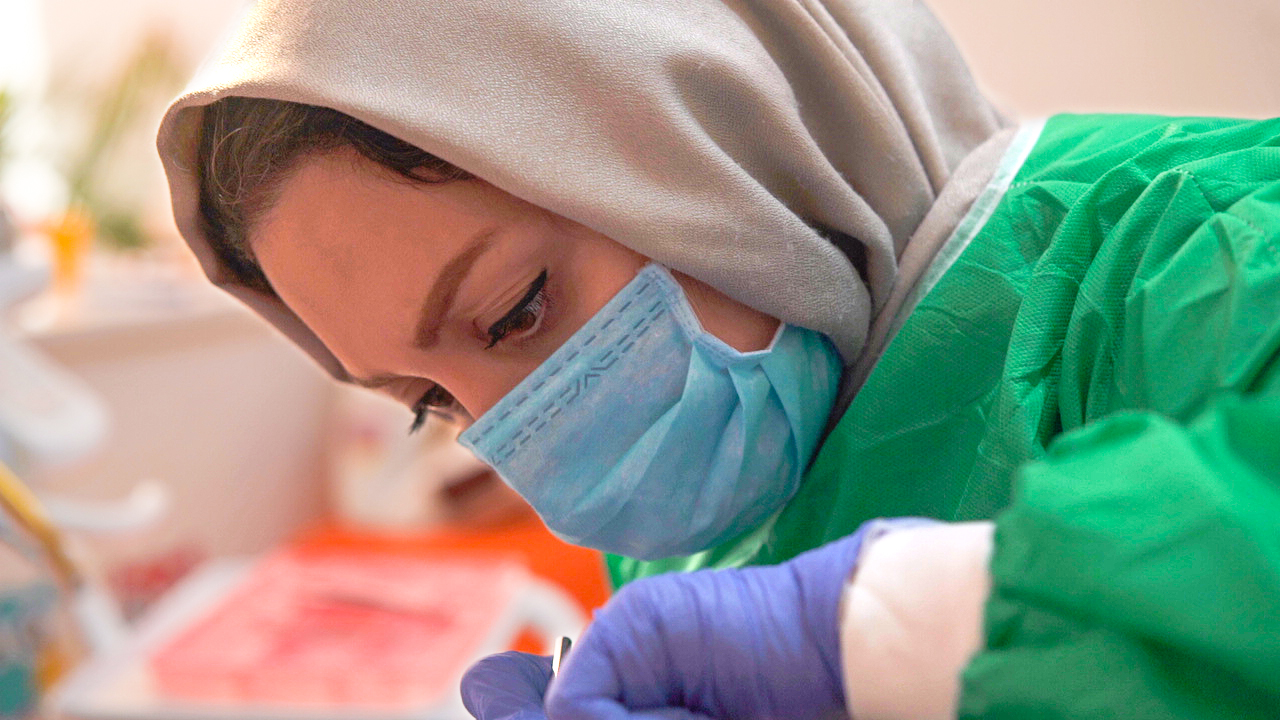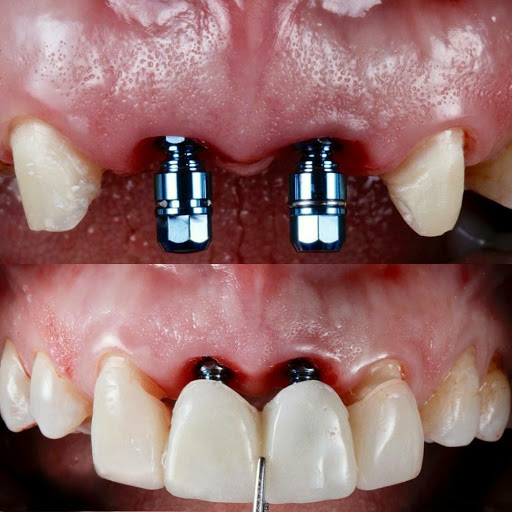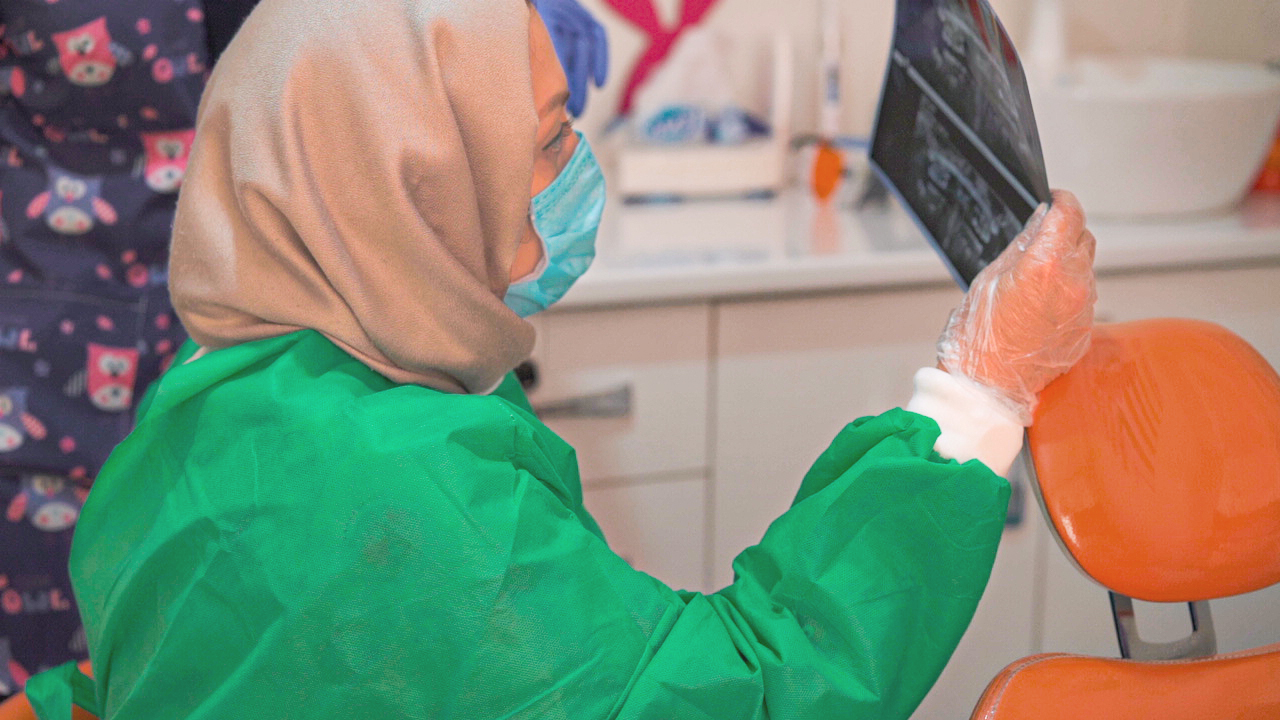EVALUATION OF DENTAL OCCLUSION IN3-5 YEAR-OLD CHILDREN
Masoumeh Moslemi1*
, Sareh Nadalizadeh2, Saforah Sarsanghizadeh3, Zahra Khalili Sadrabad4 , Zahra Shadkar5 and Mohammad.S.Shadkar6 1Pediatric Dentistry Department, Faculty of Dentistry, Shahid Beheshti University of medical Sciences, Tehran, Iran 2Pediatric Dentistry, Faculty of Dentistry, Shahid Beheshti University
3Dentist 4Pediatric Dentistry, Pediatric Department, Faculty of Dentistry, Shahed University of Medical Sciences, Tehran, Iran 5Dentist 6Economics, Tehran UniversityFaculty of Economics, Tehran, Iran
Received on 24 April, 2015
Received in revised form, 1 May, 2015
Accepted,5 May, 2015
Published 28 May, 2015
ABSTRACT: Background and Objectives: At present, due to the increased awareness of parents regarding oral health and dental esthetics, the number of dental visits has increased. Dentofacial disorders that can cause esthetic and functional problems for the child and affect dentofacial growth and developmentcan be detected during routine dental visits. This study sought to assess the occlusion of the primary dentition in 3-5 year-olds. Materials and Methods: This study was conducted on 390 children aged 3-5 years selected from Yazd kindergartens using systematic cluster sampling. Occlusal relations namely the relationship of primary second molars, the relationship of canines, overjet, overbite, cross bites, spaces, crowding and the dental midline were evaluated. The children were examined using a ruler, wooden tongue depressor and brass wire under sunlight. Results: The flush terminal plane relationship (FTP) was seen in 71.3% of the children. Mesial step (MS) relationship had higher frequency among females. The distal step (DS) and mesial step relationships increased with age.
Canine relationship was Class II in 84% of children; while Class III relationship was seen in 1.5% of children and was more prevalent among boys. Overbite has a significant correlation with age; 64.6% of boys and 59% of girls had normal overbite. Reverse overjet was not observed in any girl but was seen in 3 boys. Anterior crossbite was observed in 3.1% of children. No case of posterior openbite was found and 2.3% had posterior crossbite; which was more prevalent among girls. Primary maxillary spaces were present in 76.9% of children; 8.7% and 2.6% had mandibular and maxillary crowding, respectively. Twin teeth were present in two children and 13.1% had dental midline deviation. Conclusion: Comparison of our results with previous studies showed that occlusal relationships have variable frequencies in different populations. Attention must be paid to dental occlusion of children because timely diagnosis and treatment may prevent future problems.
INTRODUCTION: Primary teeth start to erupt at 6 months of age and complete their eruption at the age of 3 years (1). Eruption time of primary teeth is
affected by several factors (2). Occlusion means QUICK RESPONSE CODE
Corresponding author: Masoumeh Moslemi Doctorate Student, Department of Management, Policy and Curriculum Studies, School Of Education, Kenyatta University Article can be accessed online on: www.journalijmri.com Copyright © Francis ABOBOl., This is an open-access article distributed under the terms of the Creative Commons Attribution License, which permits unrestricted use, distribution and reproduction in any medium, provided the original work is properly cited.
intercuspation of upper and lower teeth when the jaws are not moving (3). Proper occlusion of teeth plays an important role in mastication, deglutition,
speech and respiration. Thus, it is extremely important to have adequate knowledge about the normal occlusion of primary teeth.
Normal occlusion of primary teeth has the following characteristics: presence of space between the incisors, primate spaces at the mesial of maxillary canines and distal of themandibular canines, placement of 2nd primary molar tooth in IJMRR
Masoumeh Moslemi et al., IJMRI, 2015; Vol. 1(1): 48-53.
International Journal of Multidisciplinary Research and information 49 occlusion as the FTP and normal overbite and overjet (2, 4).
Increased prevalence of malocclusion in developed countries is attributed to the developmental trend towards smaller jaws but Beg suggested that one reason for increased prevalence of crowding is less occlusal and proximal wear of teeth. Primary humans had a hard food diet and thus a significant
reduction occurred in the mesiodistal width of their teeth due to attrition (5). However, a consensus has been reached that variability in dental occlusion is the result of a multifactorial hereditary pattern in which both genetic and environmental factors are involved. For example, variability in the space between primary incisors is the result of both genetic and environmental factors; whereas, spacing in the posterior teeth is not congenital and is caused as the result of environmental factors. Concerning overbite and overjet, it has been proven that overbite is congenital and overjet is caused by environmental factors (6). In fact, malocclusions are mainly due to the imbalance between developing systems that comprise the craniofacial complex. The developing face is not able to confront such discrepancies (2). n the ages of 3-6 years, malocclusions can be detected primarily. Anterior openbite is a common malocclusion caused by thumb sucking during childhood (7). According to Melink, posterior cross- bite in primary dentition is the most common malocclusion among Caucasian children. If not corrected immediately, this condition leads to facial asymmetry and TMJ disorders. Other than genetics, factors namely non-nutritional sucking and impaired nasal breathing due to enlarged tonsils or adenoids can also cause posterior crossbite (8). Bruxism is another cause of malocclusion and Ghafourynia et
al,noticeda significant association of bruxism with FTP and mesial step occlusion (9). Ethnic and racial differences are also responsible for the variability of occlusion in the primary dentition. For example, Birya et al, (10) in their study in Tehran reported a high prevalence of Cl canine relationship; whereas the frequency of this relationship was far less in a study by Pascal Chill in France (11). By early recognition of such disorders, clinicians
can prevent andtreatdental problems at a younger age.
MATERIALS AND METHODS: This descriptive, epidemiological cross-sectional study was conducted on 3-5 year old children selected from kindergartens in Yazd in 2004 using systematic cluster sampling. A total of 390 children including 195 girls and 195 boys were chosen using the formula N=Z2 . The inclusion criteria were: no systemic diseases, no history of orthodontic treatment, complete primary dentition and no erupted permanent tooth, no missing tooth and no marginal ridge cavities. All examinations were done in centric occlusion (CO). Overjet was measured using a ruler and wooden tongue depressor. For evaluation of
primary spaces, a brass wire with 0.25 mm diameter was used. In case of presence of adequate
space, this wire would easily pass through the space between the primary maxillary lateral incisor and canine and the mandibular canine and first primary molar tooth.
The relationship of primary molars (right and left) and primary canines, overjet, overbite, anterior crossbite (one or more mandibular incisors are placed ahead of their maxillary corresponding teeth in CO) and posterior crossbite (primary maxillary molars are placed lingually relative to mandibular molars in CO) were evaluated. Crowding, primary and interdental spaces and position of midline (midline deviation was defined as any deviation of the midline from the midsagittal plane in CO) were assessed as well. Data were entered in SPSS version 8 and 11 software and chi-square test was used for the comparison of occlusion variables for both genders.
RESULTS: In evaluation of right and left primary molars, FTP relationship had the highest prevalence (71.3%) while distal step relationship had the
Masoumeh Moslemi et al., IJMRI, 2015; Vol. 1(1): 48-53.
International Journal of Multidisciplinary Research and information 50 lowest frequency (2.8%). Table 1 shows the number
and percentage of right and left primary molar relationships in both genders. Evaluation of the relationship of right and left primary canines revealed that CL I had the highest and CL II had the lowest prevalence (Table 2). In evaluation of overbite, in a total of 390 children, 61.8% had normal overbite out of which, 64.6% were boys and 59% were girls. Posterior openbite was not seen in any child. Normal overbite was the most common and anterior openbite was the least common pattern (Table 3). In evaluation of overjet, 75.4% of patients were normal including 139 boys (71.3%) and 155 girls (79.5%). Only 3 boys (1.5%) had reverse overjet. None of the girls had reverse overjet (Table 4). In evaluation of anterior crossbite, of 195 boys, 8 (4.1%) had anterior crossbite and 187 (95.9%) did not. Of 195 girls, 4 (2.1%) had anterior crossbite and 191 (97.9%) did not.
In evaluation of posterior cross-bite of 195 boys, 2 (1%) and of 195 girls 7 (3.6%) had posterior crossbite (Figure 1).
Maxillary and mandibular crowding was also evaluated. Of 195 boys 3 (1.5%) had maxillary and 11 (5.6%) had mandibular crowding. Of 195 girls, 7 (3.6%) had maxillary and 23 (11.8%) had mandibular crowding.
Table 1 Frequency distribution of primary molar teeth relationshipsin boys and girls Gender/Relationship of right and left primary 2nd molars Boys Girls Total Number Percentage Number Percentage Number Percentage FTP 138 70.8 140 71.8 278 71.3 MS 50 25.6 51 26.2 101 25.9 DS 7 3.6 4 0.5 11 2.8 Total 195 100 195 100 390 100 Table 2 Frequency distribution of primary canine teeth relationships in boys and girls Gender/Relationship of right and left primary canines
Boys Girls Total Number Percentage Number Percentage Number Percentage
CL I 161 28.6 167 85.6 328 84.1
CL II 30 15.3 26 13.3 56 14.4
CL III 4 0.5 2 1.1 6 1.5
Total 195 100 195 100 390 100
Table 3 Frequency distribution of overbite in boys and girls
Gender/Overbite Boys Girls Total
Number Percentage Number Percentage Number Percentage
Normal 126 64.6 115 59 241 61.8
Deep 50 25.6 44 22.6 97 24.1
Edge to edge 11 5.6 19 9.7 30 7.7
Anterior openbite 8 4.1 17 8.7 25 6.4
Total 195 100 195 100 390 100
Table 4 Frequency distribution of overjet in boys and girls
Gender/Overjet Boys Girls Total
Number Percentage Number Percentage Number Percentage
Normal 139 71.3 155 79.5 294 75.4
Increased 53 27.2 40 20.5 93 23.8
Reverse 3 1.5 0 0 3 0.8
Total 195 100 195 100 390 100
Figure 1 Evaluation of anterior and posterior crossbite in girls and boys
Masoumeh Moslemi et al., IJMRI, 2015; Vol. 1(1): 48-53.
International Journal of Multidisciplinary Research and information 51 In evaluation of interdental spacing, 15.1% had no interdental space in either jaw and 6.4% had interdental spacing in both jaws (at least one space in the anterior and one in the posterior region) and the remaining children had interdental spaces in only one jaw or only one space. Figure 1-2 shows the frequency distribution of maxillary and mandibular interdental spaces.
In evaluation of midline, of 195 boys, 27 (13.8%) and of 195 girls, 24 (12.3%) had midline deviation.
Twin teeth were observed in one boy and one girl. DISCUSSION: This study showed that 71.3% of children had FTP relationship; which is similar to the results of Eshghi (70%) in Isfahan (12) and Farsi (80%) in Saudi Arabia (13). This rate was 55.4% in a study by Birya, and 37% in a study by Abu Alhaija in 2003. Such differences in results may be due to the different understudy populations (14). Bilateral mesial step and distal step in our study had
a prevalence of 26% and 2.8%, respectively. Distal step molar relationship had a prevalence of 7% in
boys and 4% in girls. Mesial step was more frequent in girls which is similar to the results of Birya and Eshghi. The difference in this respect between boys and girls is probably due to the effects of genetics on tooth and jaw size. Concerning primary canine relationship, the CL I pattern had the highest prevalence (84.1%); which is in accord with the results of Talebi in Mashad
(77.1%)(15) but different from the rate reported by Pascal Chill in 1997 in France (47.6%). These differences are explained by the effects of genetics and environment on dental occlusion (12). CL II canine relationship had a frequency of 14.4% in our study; which is close to the results of Birya (13.3%), Eshghi (12%) and Farsi (15%); however, Pascal Chill reported a prevalence of 52% for CL II canine relationship. CL III canine relationship in our study had a prevalence of 1.5%. This rate was 9.4% in the study by Birya, 3.3% in the study by Farsi and 0.5% in the study by Pascal Chill. We found no significant association between gender and canine relationship which may be due to differences in ethnicity, sample size or methodology.
Overbite was normal in the majority of children (61.8%) which is in accord with the findings of Birya, Farsi and Otuyemi (1996, Nigeria)(16). Only 6.4% of patients had anterior openbite. The number of affected girls was twice that of boys. This finding is in accord with the results of Hugh et al, in Australia. They evaluated primary dentition of Australian twins and singletons and concluded that overbite among females had higher variability and girls had higher frequency of openbite ranging from 0-4 mm. However, this condition was not observed in any of the boys (6). This finding is in contrast to the results of Chevitaresa in Brazilwho reported a prevalence of 49.8% for openbite (17).
The reason can be ethnic and methodological differences. We found a significant association between gender and overbite. Birya, Chevitaresa (Brazil), Hugh (Australia) and our study reported deeper bites in boys but Eshghi observed that girls had a deeper bite. In our study, normal overjet (0-2mm)(75.4%) was the most common traitwhich is in agreement with the results of Birya (79.2%) and Farsi (75.7%). Reverse overjet was seen only in 3 boys (0.8%). This rate was 2% in Birya’s study. We found a significant association between gender and overjet but no such correlation was found in the studies by Hugh and Birya. These differences may be due to ethnic differences and study criteria.
Figure 2 Presence of interdental spaces in girls and boys
Masoumeh Moslemi et al., IJMRI, 2015; Vol. 1(1): 48-53.
International Journal of Multidisciplinary Research and information 52 Posterior crossbite in CO in our study was seen in 2.3% of the children. This rate was 4% in a study by Farsi, 10.8% in a study by Chevitaresa and 7% in a study by Abu Alhaija. In our study, posterior crossbite was more prevalent among girls which is in accord with the results of Birya. Anterior crossbite had a prevalence of 3.1% which is in accord with many other studies. These differences are due to different habits of communities (posterior crossbite is usually caused by the unilateral maxillary contraction attributed to oral habits). We had no case of posterior openbite. In a study by Birya three patients had unilateral posterior openbite.
In our study, 2.6% and 8.7% had maxillary and mandibular crowding, respectively; this is in agreement with the results of Birya, Eshghi and Farsi. In a study by Hugh in Australia, crowded arches had a low frequency. In a study by Talebi, lack of primary space in the mandible had a higher frequency than in the maxilla (14.6% versus 8.3%).
Presence of generalized interdental spaces were observed inthe maxilla in 75% and in the mandible in 70.8% of the cases. Crowding or lack of space between primary teeth caused crowding of the mixed dentition.
Crowding of the maxillary and mandibular arches in our study was more prevalent among girls. Mandibular crowding had a significant correlation with gender. In the study by Birya, mandibular crowding had a prevalence of 9.9% in the mandible and 1.2% in the maxilla.
CONCLUSION: Many studies have been conducted on dental occlusion in different communities.Ethnic, behavioral and nutritional differences have also been assessed. Our study showed that many malocclusions need to be treated at early ages such as posterior crossbite (2.3%) and
reverse overjet (0.8%). Special attention should be paid to occlusion of primary dentition since timely diagnosis and treatment may obviate future
complications.
ACKNOWLEDGMENTS:This paper has been entirely drawn up from an “M.D. Thesis” which was
successfully completed by Dr. Saforah
Sarsanghizadeh under the supervision of Prof. M.
Moslemi and with the cooperation of Dr. Sareh
Nadalizadeh and Pediatric Department, Faculty of
Dentistry, Shahid Beheshti University of Medical
Sciences and Statistical analysis was performed
under the supervision of Mr. Mohammad Saeid
Shadkar.
REFRENCES:
1. Abu Alhaija ES, Qudeimat MA. Occlusion and tooth arch dimensions in the primary dentition of preschool Jordanian children. Int J Paediatr Dent. 2003 Jul, 13(4): 230, 9.
2. Andlaw R. J . Rock W. P
3. Cadena Galdos A. Hinojosa A. Malocclusion in primary dentition. Rev ADM. 1990 May-June; 47(3) : 107,11
4. Chevitaresa AB, Dell valle D. Moreira Tc. Prevalence of malocclusion in 4-6 year old Brazilian children. J chin pediatr dent. 2002 fall; 27(1) : 81,5.
5. Eshghi. E, Kosari. Evaluation of types of occlusion and intercuspation in primary teeth of children in age of 36-60 month in Esfahan kindergardens. undergraduate thesis. Tehran university 1374.
6. Ghafournia M., Relationship between bruxism and malocclusion among preschool children in Isfahan, Dent Res Dent Clin Dent Prospects. 2012 autumn; 6(4): 138-142.
7. Hughes, T., Thomas, C., 2001. A study of occlusal variation in the primary dentition of Astralian twins and singletons. Archives of oral biology 46(2001) 857-864.
8. Ischill p, Bacon W, sonko A. Malocclusion in the deciduous dentition of Caucasian children. Eur J orthod. 1997 Aug
;19(4) : 361,7.
9. M. Rahmani, M. Biriya. Evaluation of occlusion in 3-5 year old nurseryschools children in Tehran–2003. J Dent Sch. 2004; 21 (4) :661-670 . 10. Najat M.A. Farsi fouad S . Salama: Characteristics of primary dentition occlusion in a group of Saudi children, J paediatric dentistry, 1996. 6(4): 253-9.
11. Otugemi Eo. Sote. Occlusal relationships and spacing or crowding of teeth in the dentition of 3-4 years old Nigerian children, Int j pediat dent 1998. 22(4): 329-334.
12. Prophit W.R. Contemporary orthodontics. Jahad deneshgahi Mashhad publication. Spring 1377.
13. Robert E . Moyers: Hand book of orthodontics, 4th edition, Chicago 1988 : 25, 6-133
14. Ronald S . Penido, Robert carrel, A. G chialastri: occlusal assessment of 3-5 year population, paediatric dentistry 1979, 2(1) : 104, 107.
15. Stasa Melink., Posterior cross bite in the deciduous dentition period,its relation with sucking habits , irregular orofacial functions, and otolaryngological findings. American journal of orthodontics and dentofacial orthopedics 2010; volume 138, number 1.
16. Surrender K. Nanda. Developmental basis of occlusion and malocclusion. Jahad deneshgahi Mashhad publication. Spring 1377. 1 st edition.Page 22.
17. Talebi M, Ajami B, Sahebalam R. Evaluation of the occlusion and arch dimensions in the primary dentition of an Iranian population. J Dent Mater Tech 2013; 2(1): 11-6.
Masoumeh Moslemi et al., IJMRI, 2015; Vol. 1(1): 48-53.
International Journal of Multidisciplinary Research and information 53 How to cite this article:
Masoumeh Moslemi et al., Factors Affecting Effective Teaching Of Life Skills On Hiv And Aids In Secondary Schools In Gucha South






